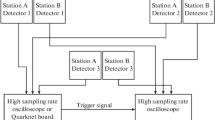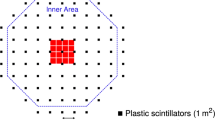Abstract
The Large High Altitude Air Shower Observatory (LHAASO) is a new generation extensive air shower (EAS) experiment focusing on high energy gamma ray astronomy and cosmic ray physics. In the LHAASO, 5242 electromagnetic particle detectors (EDs) and 1171 muon detectors (MDs), which cover an area of 1.3 km\(^{2}\), are designed to measure the number density and arrival time of EAS secondary particles. The remoteness and numerous detectors extremely demand a robust, automatic calibration method. In this work, a self-calibration method which uses charged particles within the EASs as the calibration beam is developed. The method is implemented in the Monte Carlo simulation and initially applied in a prototype array experiment, from which the precision and efficiency are estimated.
Access this chapter
Tax calculation will be finalised at checkout
Purchases are for personal use only
Similar content being viewed by others
Notes
- 1.
l = sin\(\theta \)cos\(\phi \), m = sin\(\theta \)sin\(\phi \) (\(\theta \) and \(\phi \) are the reconstructed zenith and azimuth angles, respectively).
References
Cao, Z.: Nucl. Instr. Meth. A 742, 95–98 (2014)
Cui, S., et al.: Astropart. Phys. 54, 86–92 (2014)
Zhang, Z., et al.: Nucl. Instr. Meth. A 845, 429–433 (2017)
Liu, X., et al.: Chin. Phys. C 40(7), 076101 (2016)
Du, Q., et al.: Nucl. Instr. Meth. A 732, 488–492 (2013)
He, H.H., et al.: Astropart. Phys. 27, 528–532 (2007)
Author information
Authors and Affiliations
Corresponding author
Editor information
Editors and Affiliations
Rights and permissions
Copyright information
© 2018 Springer Nature Singapore Pte Ltd.
About this paper
Cite this paper
Lv, H., He, H., Sheng, X., Liu, J. (2018). Timing Calibration of the LHAASO-KM2A Electromagnetic Particle Detectors Using Charged Particles Within the Extensive Air Showers. In: Liu, ZA. (eds) Proceedings of International Conference on Technology and Instrumentation in Particle Physics 2017. TIPP 2017. Springer Proceedings in Physics, vol 212. Springer, Singapore. https://doi.org/10.1007/978-981-13-1313-4_7
Download citation
DOI: https://doi.org/10.1007/978-981-13-1313-4_7
Published:
Publisher Name: Springer, Singapore
Print ISBN: 978-981-13-1312-7
Online ISBN: 978-981-13-1313-4
eBook Packages: Physics and AstronomyPhysics and Astronomy (R0)




